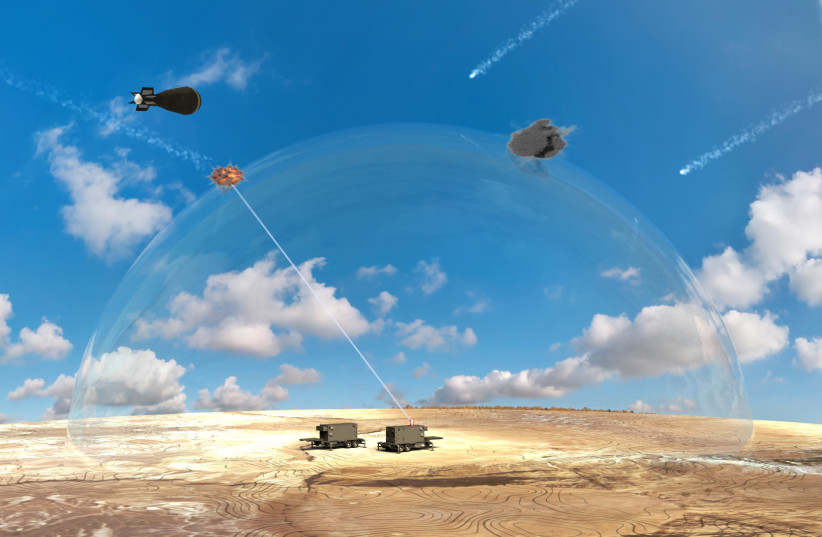‘Sky Sonic’: Israel’s Rafael developing anti-hypersonic missile for combat
Rafael Advanced Defense Systems on Wednesday announced that it is midstream in working on developing a system to shoot down hypersonic missiles, dubbing its new project the “Sky Sonic” system.
Chairman Yuval Steinitz said that the current era has more of a focus on the threat posed by hypersonic missiles.
Steinitz said that while many define any missile which can fly at a speed beyond Mach 10 as “hypersonic,” the new threat that such missiles present is their ability to maneuver and alter their trajectory.
Many countries have expressed concern that no existing air defense, including Israel’s multi-tier defenses, could contend with such a threat.
Russia, China, and Iran have all made various claims about possessing or working on developing such advanced missiles.
 Artistic depiction of how innovative laser defense system would function on the battle field (credit: Courtesy)
Artistic depiction of how innovative laser defense system would function on the battle field (credit: Courtesy)He said that the Sky Sonic defense missile system is “versatile and can hit all hypersonic missiles, flying high or low, maneuvering more or less.”
Further, the Rafael chairman said the new defense system “is already in development for a solution. If someone thought we are going downward in defense, we are deep into this.”
Next, Rafael CEO Yoav Har Even added, “We decided three years ago before the public started talking about it…we identified this as the next thing which must have a solution.”
Har Even said Rafael initiated its project for the simple reason that it fulfills the company’s two key missions: developing solutions helpful to Israel’s defense and which are at the forefront of technological development.
Steinitz said that Rafael was revealing its work on the project leading into next week’s Paris Air Show, which shows off state-of-the-art defense sector systems, and following a process to convince the Defense Ministry to approve the announcement.
Hypersonic missiles pose a unique threat
Rafael explained that the anticipated threat of hypersonic missiles would involve such threats dropping from the top of their trajectory in multiple hops, versus going high up into the atmosphere in a relatively straight line and coming back down in a similar straight line.
Such hypersonic missiles might only drop below the 20-kilometer height where existing air defense systems can hit them, at almost the last second before hitting a target.
This could defeat the mission of existing air defenses which are designed to hit missile threats during their arch trajectory going upward before they start to go downward.
Some hypersonic missiles might also be fired in more of a “line drive” fashion, closer to being fired straight across from the launch site, with much less of an arch.
These hypersonic missiles may fly above the key 20-kilometer height for existing systems to hit them during almost the entire trajectory even though they fly in more of a line-drive fashion, and with a smaller arch.
Steinitz noted that Rafael had hit a new high of NIS 40 billion in sales over the last year, a huge spike following the Russian invasion of Ukraine.
He said that Europe watched the war and realized that most of the attacks at a certain point were carried out by firing missiles, including Moscow’s claim that it was firing hypersonic missiles.
This meant new opportunities for Rafael in sales to European countries.
Rafael also discussed progress regarding its Iron Beam laser anti-missile system and its existing Iron Dome and David’s Sling anti-missile systems, noting that there would be many common features between the new Sky Sonic system and David’s Sling.
At the same time, Rafael emphasized that it is building Sky Sonic in a manner that should make it adaptable to a number of situations and scenarios.





Comments are closed.